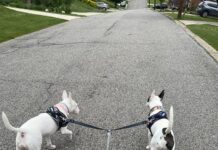Fence aggression – barking, lunging, and fence-fighting – is an all-too-common canine behavior. It can also be a very difficult behavior to live with. A dog who is left for long periods of time (especially) in an enclosed yard can easily become frustrated and aroused by dogs being walked past her space and her inability to interact with those dogs. That frustration often turns into aggression, and the aggression can become very serious. Dogs can even be grieviously injured or even killed if they are able to grab another dog (or part of a dog) through a fence.
It’s no fun for the leashed dogs either, as they make their rounds around the neighborhood with their humans and are repeatedly charged at by barking, snarling dogs.
By the way, this phenomenon isn’t limited to physical fences. The underground shock fence – a most unfortunate invention for a long list of reasons – can also trigger similar responses, often exacerbated by the “fenced” dog’s additional pain association with the non-visible barrier.
I sympathize with families who live in suburban and urban environments where dogs being walked on leash on the sidewalk is a very regular occurrence – perhaps many times a day – triggering the resulting barrier aggression. It can be even more of a challenge when neighbors have common fencelines and the dogs on both sides of the fence are reacting to passersby and to each other. I have a number of clients whose dogs’ overall behavioral challenges are significantly exacerbated by the fact that they must constantly manage interactions through the fence with next-door dogs.
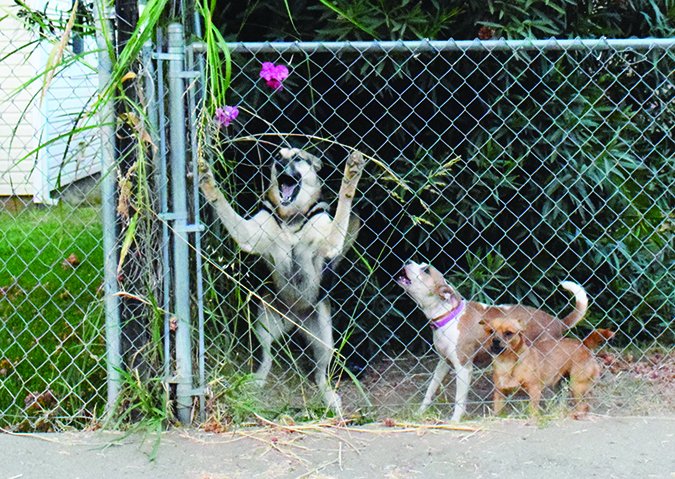
Why Fence Aggression?
In decades past, before we as a culture became more responsible about keeping our dogs safe at home, a fenced yard was a relatively rare phenomenon. The family dog was often allowed to roam the neighborhood and interact freely with other neighborhood dogs and humans. In general, they were better socialized and fence aggression was uncommon. Of course, dogs also routinely got hit by cars, shot, poisoned, and just plain disappeared. I am certainly not advocating going back to the days of free-roaming dogs just to avoid fence-fighting! But we do need to look for better ways to keep dogs contained in order to avoid concomitant unwanted behaviors.
The fenced dog often really just wants to investigate, explore, and approach and meet passers-by. When thwarted, she becomes frustrated. Over time this frustration becomes a classically conditioned response, and the mere sight of another dog or other stimulus beyond the fence causes frustration, arousal, and aggression.
To compound the problem, the fenced dog is also negatively reinforced when she barks in an aroused frenzy and the stimulus goes away. She has come to perceive passing dogs and humans as intruders – “bad things” – and in her mind, the aroused barking makes the “bad things” go away; this is a textbook example of negative reinforcement. (Negative means something goes away – as in “subtraction” – and reinforcement means the behavior increases.) Our dogs naturally repeat behaviors that make “bad things” go away.
To make things worse, it’s not necessarily just other dogs. Our fenced dog can develop the same arousal and aggression toward any stimulus that routinely passes – a walker, jogger, skateboard, bicycle, motorcycle, car, or child. These can all become triggers for your dog’s fence aggression.
Barrier aggression can present behavioral challenges that go far beyond the backyard. While some dogs who have developed fence aggression can behave calmly and appropriately when presented with the stimulus in an unfenced environment, many others will generalize the frustration-association and continue to aggress even when there’s no fence. This doesn’t bode well for future encounters with other dogs, joggers, vehicles, and children.
Beware of Redirected Aggression!
Redirected aggression is a common and dangerous side-effect of barrier aggression. Say your two normally compatible dogs are running the fence side by side in their yard in a frustrated/arousal response to another dog passing by. Suddenly a fierce fight breaks out between the two yard dogs. What just happened?
Their high level of arousal has just caused them to redirect their aggression to each other. The same thing can happen to you if you try to physically interrupt your dog’s high-arousal fence-running behavior – she can redirect her aggression to you, inflicting serious bites.
It is much safer to interrupt your dog’s barrier aggression with a loud noise (bang pans together, set off a hand-held air horn, etc.) or by tossing a large soft object into her path, rather than trying to touch or grab her. Be careful!
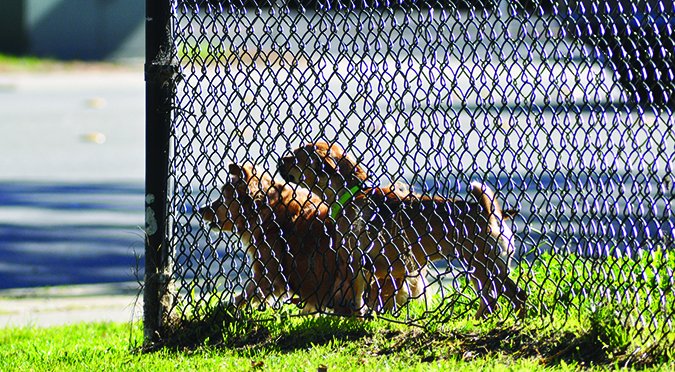
Management: The Best Defense is a Good Fence
Of course, it’s always better to prevent unwanted behaviors than it is to have to modify them later. A solid privacy fence and good management (not leaving your dog in the fenced yard unattended) can go a long way toward preventing fence aggression.
If it’s too late to prevent fence-fighting for your dog, it’s still not too late to put prevention measures in place to avoid ongoing reinforcement for the behavior. Management is critically important for successful modification, so your dog can’t continue to practice and be reinforced for the unwanted behavior.
If you can’t install a privacy fence, perhaps you can cover your existing fence with something (such as fiberglass-reinforced plastic [FRP] panels) – ideally on the outside of the fence so your dog can’t chew at it. Alternatively, you could attach tarps to the fence to create a visual barrier – although they aren’t very aesthetically pleasing.
If you share a fenceline with a neighbor dog, perhaps you can put up a second parallel fence several feet away from the existing one to create a “no-dog’s land” airlock and thereby prevent through-the-fence contact.
Other management options might include letting your dog into the backyard instead of the front (if you can) to prevent arousal at various passersby and agreeing on a schedule with your neighbor so your respective dogs are never in their backyards at the same time. If your fence-aroused dog has generalized her behavior to running back and forth at windows when she’s indoors, you can cover the bottom half of the windows and/or use gates to block access to rooms with windows.
Changing Behavior
With management options solidly in place, you can begin to work to modify your dog’s fence aggression. The goal is to give her a new association with any of the triggers that she has reacted to by feeding high-value treats when she sees another dog or any of the other various stimuli that have set her off.
To begin, choose a time when your neighbors are likely to be walking their dogs (or joggers, children, bicycles, etc. are likely to be passing by) and hang out in your yard with your dog on leash (so she can’t run the fenceline). You should be equipped with an ample supply of yummy treats. Chicken (canned, boiled, or baked) is my favorite for most dogs; it’s healthful, low-calorie, easy on stomachs, and most dogs love it.
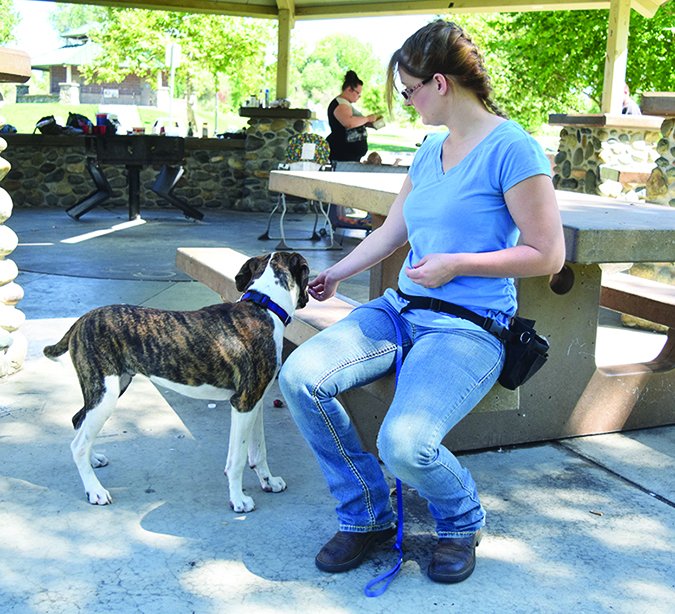
As soon as your dog notices the presence of one of the offending triggers, feed her bits of chicken. Pause, let her notice again, and feed again. Continue this notice-feed protocol until the stimulus is gone. Then wait for the next one to appear, and repeat.
This process is called counter-conditioning and desensitization (CC&D). When you give your dog a new “chicken association” with her triggers, her emotional response changes from “frustrated and aroused” to happy “Yay, chicken!” As a result, her aggressive behavior changes to a cheerful look to you for the next chicken delivery. This is called a conditioned emotional response (CER).
The key to successful CC&D is controlling the intensity of the stimulus. Your goal is to keep your dog “below threshold” – aware of the stressful trigger, but not upset by it – as you work to create the new association. You may need to start your sessions a distance of 10, 20, 30 feet or more from the actual fence in order to succeed. You want her to notice the stimulus but not bark or lunge at it. Also, your dog should be happy to eat the treats you offer; if she refuses them, she is too stressed by the proximity of the stimulus and you need to move farther away from the fence and try again.
When your dog consistently offers “Where’s my chicken?” looks, you are ready to move a little closer and continue the CC&D. Continue your slow advance until she can remain calm in the presence of her triggers even when you are right at the fence.
If you’re lucky, your dog may generalize her new happy associations beyond the fence; once you get to that point, you’re home free! If not, you will also need to do CC&D sessions in other locations. The same instructions apply: Work below threshold, obtain consistent CERs, and gradually increase intensity of stimulus until she can remain relaxed, calm, and appropriate in normal proximity to any of the things that have caused her to be fence-aggressive in the past.
Using CAT For That
CAT stands for “Constructional Aggression Treatment,” and it uses negative reinforcement to modify aggression. Your fence-fighting dog has learned that barking and lunging makes the bad dog (or other stimulus) go away. She probably doesn’t realize the other dog would have gone away anyway! Using the CAT procedure, you could teach your fence-fighting dog that calm behavior makes the other dog go away.
Start with a helper holding a leashed neutral dog (one who can be counted on to stay calm and cool, no matter what the other dog does). Position them at a sub-threshold distance – far enough away that your dog notices but does not yet react. Position yourself in your yard with your dog, and be equipped with an ample supply of high-value treats.
Have your neutral-dog team move toward your fenced dog. (Initially you are in the yard with your dog.) Instruct your helper to watch your dog closely, and stop and stand still as soon as your dog alerts on the neutral dog – but before there is any barking, etc. As soon as your dog relaxes even the teeniest bit, your helper should turn and walk away with the neutral dog. You just showed your dog that relaxing makes the other dog go away.
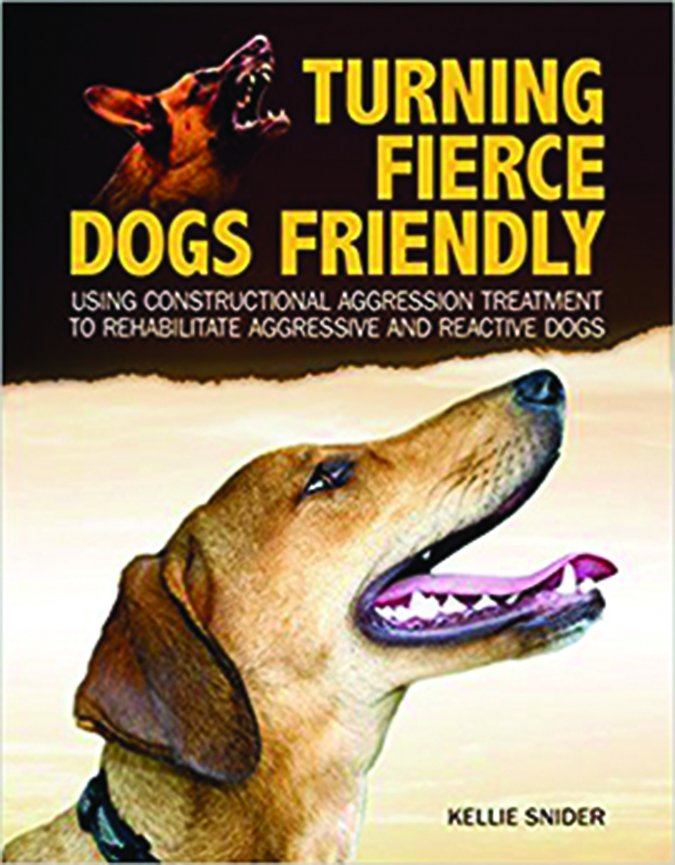
Repeat these negative reinforcement approaches and departures at the original spot until your dog no longer alerts, then have your helper take one step closer and repeat the process there. In a successful CAT procedure, your dog becomes so relaxed – because relaxation keeps getting reinforced – that she eventually no longer feels the need to “make” the leashed dog go away.
For more information on the CAT procedure, see the recently released book by CAT creator Kellie Snider, Turning Fierce Dogs Friendly: Using Constructional Aggression Treatment to Rehabilitate Aggressive and Reactive Dogs (available through Whole Dog Journal). Please note that successful implementation of the CAT procedure usually requires the guidance of an experienced canine behavior CAT professional.
Keep Managing
Finally, you will need to continue to monitor and manage your dog’s activities in her yard. While the CC&D can successfully help your dog create new associations and more agreeable behaviors, the old neuron pathways for aggression are still there in her brain. Unmanaged exposure to her triggers could easily cause the old behaviors to resurface. You don’t want that to happen after all your hard work!
Author Pat Miller, CBCC-KA, CPDT‑KA, is WDJ’s Training Editor. She lives in Fairplay, Maryland, site of her Peaceable Paws training center. Miller’s newest book is Beware of the Dog: Positive Solutions for Aggressive Behavior in Dogs.



